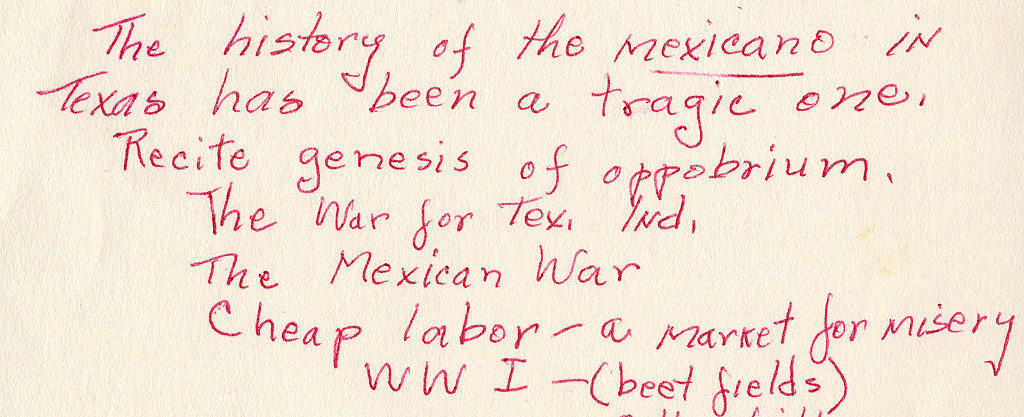
Students will learn about the work and life of educational scholar and activist, Dr. George I. Sanchez. Topics for critical exploration include Sanchez’s educational research, legal assistance, Mexican American organizations, Bilingual Education, Pan-Americanism, and Chicano Civil Rights. Students will make either a hand written/drawn zine or a digital zine based on the students’ preference and availability of materials and technology. The primary sources presented here are from the George I. Sánchez Papers, 1919-1986.
Date Range: 1919-1986
Grade Levels: 9-12
Country: United States
Course Subjects: Borderland studies; Mexican American & U.S. Latinx studies; U.S. History: 1877-present
Topics: Mexican American/ Chicano activism; civil rights; education; student organizing; Texas history
Teaching Time Frame: 8, 60 minute lessons
Guiding Questions
- Who was Dr. George I. Sanchez?
- Why was he an import figure for understanding contemporary education for Mexican Americans?
- What were the struggles that Mexican American students faced in the 20th century?
- Are these issues still relevant today? How can we use art to address social issues?
Summative Activities
- Students will make either a hand written/drawn zine or a digital zine based on the students’ preference and availability of materials and technology. Students’ final projects will promote alternative sites and formats of knowledge production. Students will engage with one another as they share their final projects.
Relevant Teaching Standards
Lesson 1-5
TEKS Guidelines
- Ethnic Studies: Mexican American Studies
- (c)-(4)-(A) – The student understands the causes and impact of the Mexican American civil rights movement from the 1930s to 1975. The student is expected to explain the significance of the following events as turning points relevant to Mexican American history: U.S. entry into World War II, Bracero Program, Longoria Affair, Operation Wetback, Hernández v. Texas, Brown v. Board of Education, Civil Rights Act of 1964, Voting Rights Act of 1965, Farmworkers strike and boycott, and establishment of La Raza Unida Party.
- (c)-(4)-(B) – Identify the contributions of significant individuals from the civil rights era.
- (c)-(8)-(D) – Evaluate the successes and failures of the Mexican American civil rights movement and the farmworkers movement.
- (c)-(9)-(D) – Analyze the connotations and histories of identity nomenclature relevant to Mexican Americans such as Mexican, Spanish, Hispanic, Latina/o, Chicana/o, illegal, undocumented, Mexican American, American Mexican, or simply American.
- (c)-(10)-(A) – The student understands the relationship between Mexican American artistic expression and the times during which the art was created. The student is expected to describe how the characteristics and issues of Mexican American history have been reflected in various genres of art, music, film, and literature.
C3 Framework
- History
- D2.His.1.9-12. Evaluate how historical events and developments were shaped by unique circumstances of time and place as well as broader historical contexts.
- D2.His.14.9-12. Analyze multiple and complex causes and effects of events in the past.
Lesson 6-8
TEKS Guidelines
- Ethnic Studies: Mexican American Studies
- (c)-(12)-(B) – The student applies critical-thinking skills to organize and use information acquired from a variety of valid sources, including electronic technology. The student is expected to analyze diverse points of view related to contemporary Mexican American issues.
- (c)-(12)-(C) – Create a written and/or oral presentation on a contemporary issue or topic relevant to Mexican Americans using critical methods of inquiry.
- (c)-(12)-(D) – Analyze information by sequencing, categorizing, identifying cause-and-effect relationships, comparing, contrasting, finding the main idea, summarizing, making generalizations and predictions, and drawing inferences and conclusions.
C3 Framework
- History
- D2.His.1.9-12. Evaluate how historical events and developments were shaped by unique circumstances of time and place as well as broader historical contexts.
- D2.His.14.9-12. Analyze multiple and complex causes and effects of events in the past.
- Taking Informed Action
- D4.6.9-12. Use disciplinary and interdisciplinary lenses to understand the characteristics and causes of local, regional, and global problems; instances of such problems in multiple contexts; and challenges and opportunities faced by those trying to address these problems over time and place.
- D4.7.9-12. Assess options for individual and collective action to address local, regional, and global problems by engaging in self-reflection, strategy identification, and complex causal reasoning.
Downloads
Rights Statement
Creator: Cassie Smith, Doctoral Candidate, Anthropology, University of New Mexico (Fall 2018)
Date: 2019-04-25
This unit is under a Creative Commons Attribution-NonCommercial-ShareAlike 4.0 International Public License (“Public License”). This license lets others share, remix, tweak, and build upon the work non-commercially, as long as they credit the creators and license their new creations under the identical terms.
